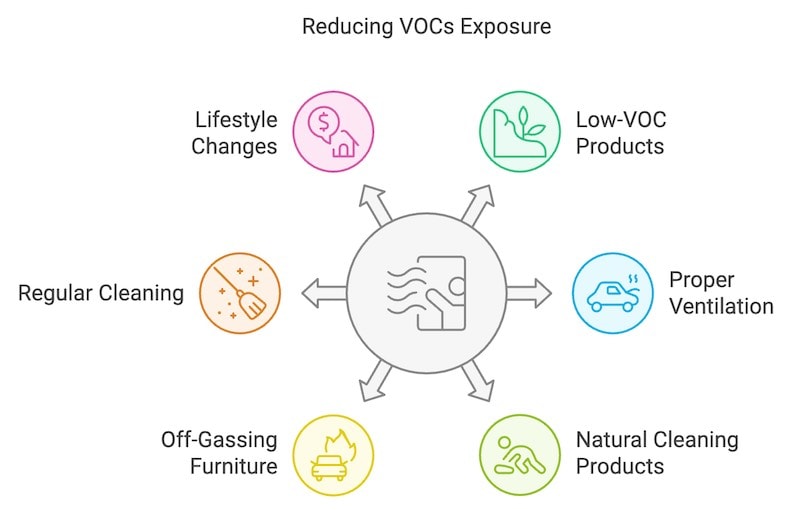Table of Contents
How to Remove VOCs from Home: Complete Guide for Cleaner Air
This page may contain affiliate links. We may earn a commission on purchases, at no additional cost to you. Learn more →
Have you ever wondered what harmful chemicals may be lingering in the air that you breathe every day? Volatile organic compounds (VOCs) are a common challenge in homes due to their widespread use across a variety of products, from scented paraffin candles to fresh paint that we use to decorate our homes. Understanding VOCs is crucial for creating a truly healthy home environment. Achieving pure air by reducing VOC exposure is essential for optimal air quality and well-being.
The good news is clearing your home of VOCs is totally doable! Over the years, I’ve learned how transformative even opening the windows and having plants could have on my air quality. With a few adjustments, you too can also improve your indoor air quality and create a space that’s safer for you and everyone who walks through your door!
Let’s dive into how you can reduce VOCS in your home today and implement small changes you can make today to improve your air quality, your health and make your living area a non-toxic space!

What are volatile organic compounds ?
Volatile organic compounds (VOCs) are man-made toxic chemicals that are emitted as gases from certain solids of liquids, found in thousands of products that we use daily. They contaminate our indoor and outdoor air, and our water supplies, disruption our health and our environment.
VOCs are up to 10 times higher indoors, compared to outdoor air, this is likely due to contributing common consumer products e.g. cleaning products, paints and building materials etc. which accumulate indoors and in situations of poor ventilation struggle to be removed.
The most common VOCs used today are:
-
Benzene found in tobacco, fuel and paint supplies. This known carcinogen is often elevated in smokers homes
-
Formaldehyde serves a purpose in the manufacturing of many products, and is often used as a preservative in paints and to coat wood products, and is usually a component of glues and adhesives
-
Toluene is a chemical derived from petroleum and used in many products as a solvent in paints, adhesives, and even nail polishes!
-
Xylene is commonly found in adhesives, coatings and in industrial strength cleaners, this is also found in vapes too
-
Styrene is found in cigarette smoke, and is used in the production of certain plastics and foams, and is a popular product for insulating homes
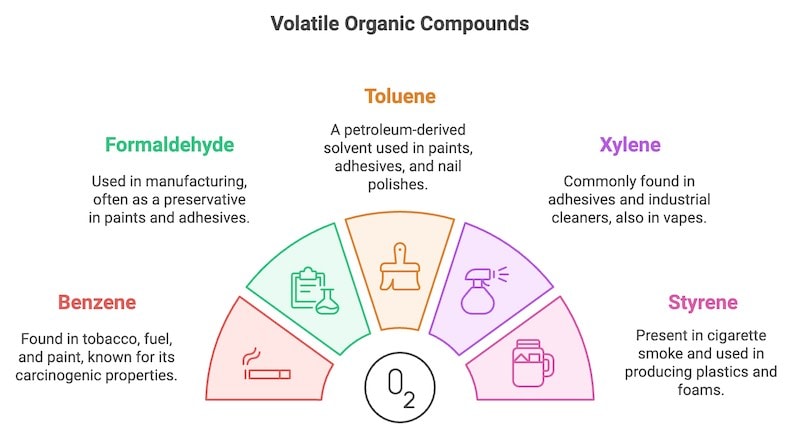
Why are VOCs harmful?
As many VOCs are odourless and you can't see them, we often don't think about them - however, just because you can't see them, does not mean they're not there! While their invisible nature might make them seem harmless, scientific research has shown that VOC exposure can impact our health in various ways.
Short-term health effects of VOCs: Common symptoms
-
Nose and throat discomfort
-
Eye and respiratory tract irritation
-
Headaches, dizziness, fatigue or nausea
-
Allergic skin reaction
Longer-term health risks associated with VOC exposure:
-
Asthma including throat irritation and wheezing
-
Cancer
-
Liver and kidney damage
-
Central nervous system damage
Who's most vulnerable? Research shows that certain groups need to be particularly mindful of VOC exposure:
-
Young children, whose developing bodies are more sensitive to environmental toxins
-
Elderly individuals with compromised immune systems
-
People with existing respiratory conditions like asthma or allergies
-
Those with chemical sensitivities
-
Workers in industries with high VOC exposure, such as painting or manufacturing
Understanding these risks is the first step toward making informed choices for a healthier home environment. In my journey toward creating a non-toxic home, I've learned that small, mindful changes in our product choices can significantly reduce VOC exposure and create a safer space for our families.
Identifying VOC Sources in Your Home
When analysing European and UK residences, 65 individual VOCs were identified when analysing indoor air quality. 80% were associated with building and construction materials, 63% of these VOCs were linked with consumer products like hairsprays, deodorants, air fresheners etc.) and 19 of the 65 VOCs identified were associated with candle and incense burning.
Sources of VOCs: Common household items with volatile organic compounds
Unfortunately , activities we rarely think twice about can significantly impact our indoor air quality and drive the number of VOCs indoors:
-
Morning routines (hairsprays, deodorants, and other personal care products)
-
Household cleaning sessions
-
Cooking and food preparation
-
Using air fresheners or scented products
In addition to these sources, VOCs are released from numerous other products and activities:
-
Building Materials: Paints, solvents, varnishes, caulks, sealants, flooring materials, and pressed wood products are significant sources of VOCs
-
Furniture including upholstery including upholstery, synthetic fabrics, conventional mattresses etc. emit VOCs
-
Personal care and household products including cosmetics like nail polishes, candles, air fresheners, cleaning products, disinfectants contribute to indoor VOC levels
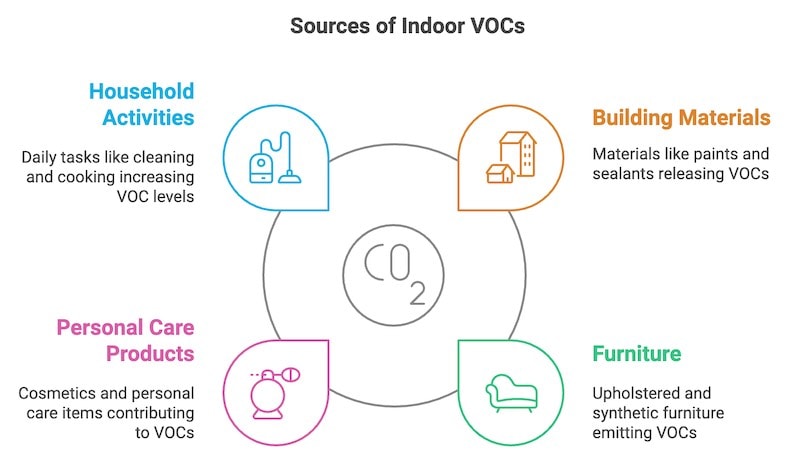
How to Reduce VOCs Exposure: Improve your Indoor Air Quality
Indoor air can be 2-5 times more polluted than outdoor air, largely due to VOCs. Research shows that conventional products can emit VOCs for months or even years. Making informed choices about the products we bring into our homes is our first line of defense. VOC removal is crucial for improving indoor air quality, and using carbon filters specifically designed for this purpose can be more effective than traditional air filters.
Through extensive research, I’ve compiled the most effective evidence-based strategies for reducing these invisible pollutants in our homes. Here’s how to make better choices:
Switch to low-VOC or no-VOC products
Low-VOC products are widely available and contain significantly lower VOC concentrations than traditional paints, and sealants etc, and release fewer fumes, typically having fewer than 50 grams of VOCs per litre.
-
To find these products, look for 'Low-VOC labels', and for building materials look for products with GreenGuard certification in products which indicates low VOC emissions.
No-VOC products release virtually no VOCs, which are desirable to health-conscious consumers and people sensitive to chemical emissions. No-VOC products usually have fewer than 5 grams per litre.
-
In building products like paint, GreenGuard and Green Seal certifications indicates compliance with stringent emission standards, and are a nothing to look for when trying to find a no-VOC product
Proper Ventilation Techniques & Air Purifiers
Scientific studies have shown that proper ventilation can reduce indoor VOC levels by up to 90%. This makes it one of our most powerful tools for improving indoor air quality. However, there are many ways you can improve your indoor air quality by reducing or removing VOCs:
-
Open your windows and doors regularly, especially when painting, using cleaning products, and even cooking, and for a while afterwards to ensure the air is clear
-
Use exhaust fans in your bathroom and kitchen, to capture and get rid of the lingering VOCs
-
Use an air purifier with activated carbon filters - carbon filters are great to trap VOCs, and are perfect in areas of high VOC concentrations. Regularly changing the air filter is also crucial to maintain indoor air quality.
-
Dehumidifiers can also be beneficial, as VOCs increase in high-humidity conditions, by reducing humidity, you can reduce your VOC levels
-
According to NASA, air purifying plants are extremely good at absorbing VOCs and improving indoor air quality, a few examples:
-
Peace Lily (removes benzene, formaldehyde)
-
Chinese Evergreen (filters various VOCs)
-
English Ivy (reduces airborne toxins by up to 60%)
-
-
When possible, use a mask or fabric to cover your nose and mouth when using cleaning products, fragranced products and paints, to protect yourself from inhaling the fumes!
Selecting Natural or Eco-Friendly cleaning products
Swapping out chemical-based cleaners with natural alternatives, or more natural products from the supermarket, can make a dramatic difference when it comes to your VOC exposure.
-
Evidence-based DIY solutions:
-
1:1 water and white vinegar (proven 99% effective against common bacteria)
-
Steam cleaning (eliminates 99.9% of germs without chemicals)
-
-
If you are looking for a more convenient option I would opt for eco-friendly cleaning products like
-
Ecover* (EcoCert certified, one of my personal favorites)
-
Seventh Generation* (EPA Safer Choice certified)
-
New furniture and renovations
Did you know that you need to let new furniture sit in a well-ventilated area like a garage or a porch for a few days to allow VOCs to be removed naturally before bringing them into your living spaces? I didn't. This is a term called 'off-gassing' and it can last from a few days to several months dependent on the material.
-
Understanding the science of off-gassing helps us make better decisions:
-
Initial off-gassing period: unbox new furniture and furnishings outside when possible, as plastic packaging can trap VOCs, 3-7 days minimum in ventilated area
-
VOC emissions typically peak in the first month
-
Temperature and humidity affect emission rates
-
Natural materials generally emit fewer VOCs
-
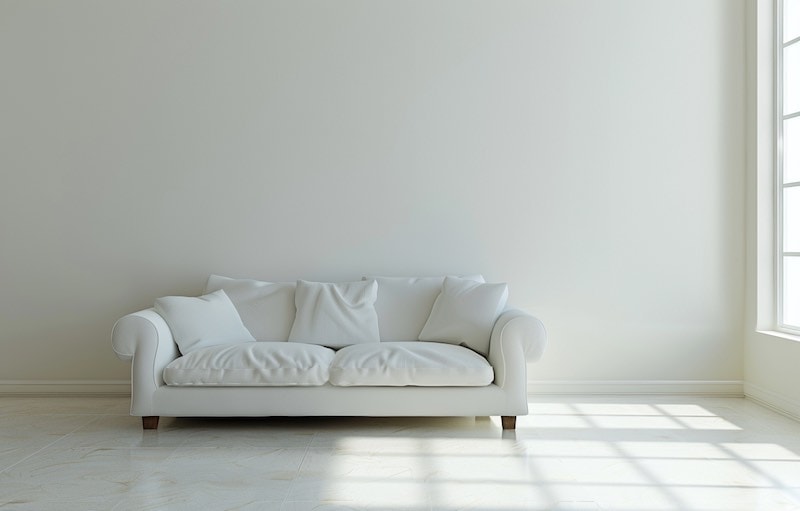
Maintain regular cleaning and dusting
This one may sound obvious, but VOCs can cling to dust, so keeping a clean environment is important, especially in newly renovated areas.
Tip: A damp mop can be helpful in removing those fine parts of dust you may have missed with a vacuum on a wooden floor.
Long-term lifestyle changes to minimize VOC exposure
Making VOC awareness part of your purchasing decisions
When renovating and purchasing new furniture opt for eco-friendly products and materials, investing in more sustainable products is worth it not only for your health, but often they end up lasting longer
-
Select solid wood over composite materials (like MDF or particle board) as these products emit more VOCS, as more adhesives are used. Solid wood is a great choice for flooring, cabinets, tables etc. as it has lower VOC emissions, and is a better investment long term
-
Favour sustainable materials over synthetic materials, choose natural fibre bedding, rugs etc, and upholstery and clothing from materials like wool, linen, hemp and cotton
-
Go electric or induction stove tops over gas - Unlike gas stoves, electric and induction stove tops do not rely on combustion and do not emit VOCs. This is a huge advantage over gas stoves as they produce formaldehyde and benzene, which accumulate especially in poorly ventilated kitchens
-
Opt for more natural and eco-friendly cosmetic products, there are plenty of non-toxic products available from scented candles and nail-polishes etc. that will not emit toxic VOCS into the atmosphere, why not give them a go!
Maintaining a minimalist and clutter-free home
By reducing unnecessary items, you can limit VOC sources, a minimalist and non-toxic lifestyle naturally limits indoor pollutants
-
Quality over quantity, opt for fewer high quality pieces over synthetic or inexpensive furnishings when possible
-
Choose natural and more sustainable finishes - using natural oils like olive oil, beeswax, and low-VOC sealants, you can protect your wood surfaces instead of using synthetic varnishes which will over time tarnish your wood and release harmful pollutants into your indoor space
Storage Recommendations & Regular Ventilation
-
Using airtight lids and containers for partially used products and for when not in use, can protect you from unnecessary VOC exposure
-
Wherever possible, store VOC-emitting products in a location that is detached from your main living areas e.g. a shed, garage etc. this keeps VOCs away from your inside space
-
Develop a ventilation routine - make a habit of regularly opening windows and running exhaust fans in the kitchen and bathroom, as fresh air dilutes indoor pollutants which helps reduce the buildup of VOCs over time
Consider Indoor Air Quality Monitoring & Humidity Control
-
If you are concerned about your indoor air quality, you can measure VOCs in real-time using an indoor air quality monitor (IAQ), this can help you track your air quality, and can indicate if more ventilation is required in your property
-
Humidity control is another great option, as VOCs and other air pollutants thrive in high humidity, you should aim to keep your home in the range of between 40-60% to avoid this!
Key Takeaways
-
VOCs are everywhere - we can admit VOCs are pretty hard to avoid as they are in so many of our everyday items, from paints to furnitures, and our personal care products, but we can reduce our exposure to harmful VOCs in our homes
-
Choose low- and no-VOC alternatives when it comes to paints, cleaning supplies and building materials
-
Boost your fresh air flow! - ventilation is the most important, regularly open your windows use exhaust fans, and maybe even invest in an air purifiers with carbon filters to remove VOCs and improve air quality
-
Favor Natural and Durable Materials - reduce VOCs by selecting natural, solid wood furniture, eco-friendly fabrics over synthetic materials as these alternatives are more non-toxic and sustainable! Also remember to off gas new furnishings away from your main living space in a well ventilated area
-
Store and Clean Smartly - keep VOC-releasing products in airtight containers away from main living areas and clean frequently to remove dust that can trap VOCs
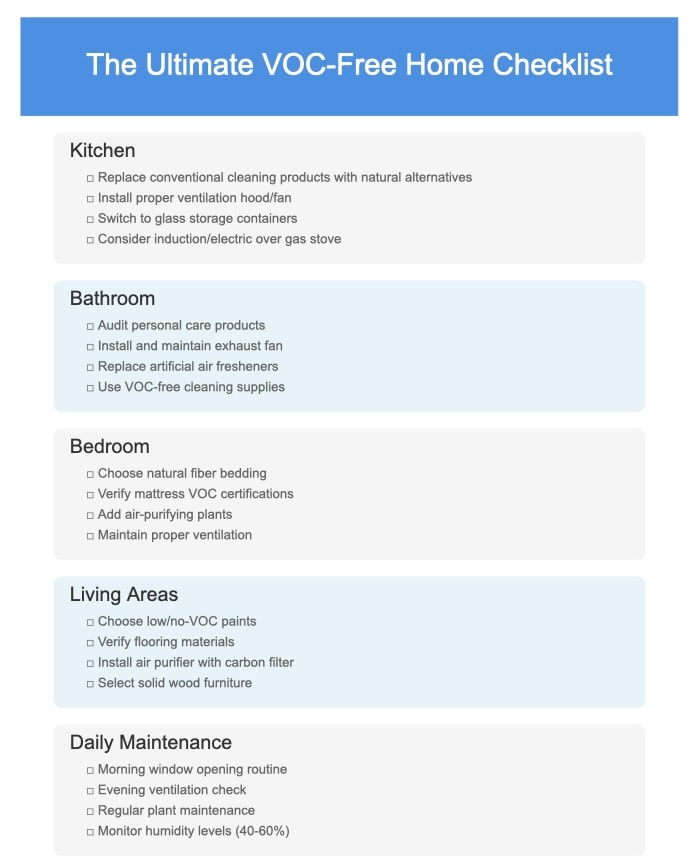
FAQ to How to Remove Volatile Organic Compounds
What is the best way to eliminate VOCs from your home?
The best way to eliminate VOCs from your home is by increasing ventilation through open windows and using exhaust fans. Additionally, you can reduce VOC sources by selecting low-VOC or no-VOC products, and regularly cleaning surfaces to remove VOCs that may have settled over time
Do air purifiers really remove VOCs?
Some air purifiers, especially those equipped with activated carbon filters or photocatalytic oxidation (PCO) technology, can remove VOCs. However, traditional HEPA filters are not effective for VOC removal as they are designed to capture particulate matter rather than gases
How do I remove VOCs from my house?
You can remove VOCs by improving ventilation (opening windows and using fans), using air purifiers with activated carbon or PCO filters, and reducing the use of products that emit VOCs. Regular cleaning of surfaces where VOCs may have settled also helps in reducing their levels
Can VOCs be removed?
Yes, VOCs can be removed through a combination of ventilation, using specialized air purifiers, and eliminating or reducing sources of VOC emissions such as paints, cleaning products, and furniture that off-gas

